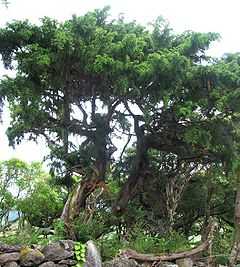Juniperus brevifolia
| Juniperus brevifolia | |
|---|---|
 | |
| Specimen on Flores, Azores | |
| Conservation status | |
| Scientific classification | |
| Kingdom: | Plantae |
| Division: | Pinophyta |
| Class: | Pinopsida |
| Order: | Pinales |
| Family: | Cupressaceae |
| Genus: | Juniperus |
| Species: | J. brevifolia |
| Binomial name | |
| Juniperus brevifolia (Seub.) Antoine | |
Juniperus brevifolia (Azores Juniper) is a species of juniper, endemic to the Azores (on Corvo, Faial, Flores, Pico, Santa Maria, São Jorge, São Miguel, and Terceira), where it occurs at altitudes of 240-800 m, rarely up to 1,500 m. It is closely related to Juniperus oxycedrus (Prickly Juniper) of the Mediterranean region and Juniperus cedrus (Canary Islands Juniper) of the Canary Islands. It is threatened by habitat loss.[1][2][3]
It is a shrub or small tree growing to a height of 6 m and a trunk diameter up to 50 cm. The leaves are evergreen, needle-like, in whorls of three, glaucous green, 4-10 mm long and 1-3 mm broad, with a double white stomatal band (split by a green midrib) on the inner surface. It is dioecious, with separate male and female plants. The seed cones are berry-like, green ripening in 18 months to orange-red with a variable pink waxy coating; they are spherical, 6-9 mm diameter, and have three or six fused scales in one or two whorls of three, the three larger scales each with a single seed. The seeds are dispersed when birds eat the cones, digesting the fleshy scales and passing the hard seeds in their droppings. The male cones are yellow, 2-3 mm long, and fall soon after shedding their pollen in early spring.[1][2]
It is endangered in its native range due to a combination of historical felling for the valuable wood and competition from invasive introduced plants.[2]
References
- ↑ 1.0 1.1 Adams, R. P. (2004). Junipers of the World. Trafford. ISBN 1-4120-4250-X
- ↑ 2.0 2.1 2.2 Farjon, A. (2005). Monograph of Cupressaceae and Sciadopitys. Royal Botanic Gardens, Kew. ISBN 1-84246-068-4
- ↑ Conifer Specialist Group 1998: Juniperus brevifolia
